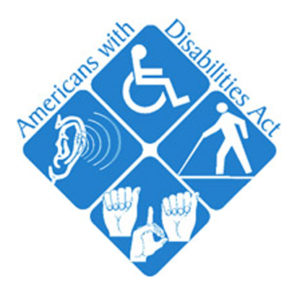ADA Compliance Standards – How to Avoid a Lawsuit
Date: April 7, 2021Category: Author: David Hall
In early 2018, we published a post on this blog about the Americans with Disabilities Act (ADA) and dental websites. In that post we explained that the Americans with Disabilities Act, enacted in 1990, was meant to apply to physical barriers only, but there were growing calls for it to be made applicable to websites. However, no one had a clear idea at that time what those standards would be.
After considerable research, I have pretty good clarity now on what you need to do, so let’s bring that information up-to-date and help you know what you can do to avoid an ADA lawsuit.
The government has still not enacted any regulations specifying any standards for websites.
Meanwhile, the courts have since established that websites do indeed need to be accessible to people with disabilities. A landmark case in 2019 seemed to settle the issue. Domino’s Pizza was sued because a man with impaired vision was not able to order a pizza through their app. The district court affirmed that the website and app needed to be accessible to the visually impaired but dismissed the lawsuit saying that Domino’s needed to be given fair notice. The 9th Circuit then reversed that decision and ordered Domino’s to make its website and app accessible. In October, 2019, the Supreme Court refused to take up the case, leaving that decision in place and making website and app accessibility the law of the land. Since then, lawsuits over website accessibility have been accelerating. Currently, about one website accessibility lawsuit is being filed every day in federal court.
The accessibility “rules” that are meant to specify exactly what webmasters need to do are published by the World Wide Web Consortium, and they are called Web Content Accessibility Guidelines (WCAG). First published in 1999, their latest version of those rules are WCAG 2.1, published in June, 2018. The problem with these guidelines is that they are so stringent that it can be very costly to make a website fully compliant. Estimates have been given anywhere from $3000 up to $50,000 to make a website fully compliant. The California Dental Association reported in a June 2020 article that one dentist informed them that they were quoted $10,000 to evaluate their website and a $500 monthly fee to monitor it. They checked with a consultant who said that pricing is in the range of what website accessibility compliance consultants charge. But is that really what the law requires?
Wanting to get a better answer, I decided to do some research to find an authoritative answer, and came across some material from a lawyer in New York who specializes in defending businesses against website accessibility lawsuits. His name is Martin Krezalek. He is a partner in the BlankRome law firm in New York City, has successfully defended a number of companies hit with website accessibility lawsuits, and frequently lectures and publishes articles on the subject. He has an excellent webinar published on YouTube that helps a great deal in understanding this.
In that webinar, he explains that there are a lot of website accessibility lawsuits being filed in the country. It comes out to thousands a year, and they constitute 1/3 of all the ADA lawsuits. Most of them are being filed by just ten law firms. They target an industry or maybe a geographic area. They scan the website with a software tool that gives them a report of how compliant the website is with accessibility standards. If it scores poorly, they will send a letter to the business with a list of the errors in the website and notify them of their intent to sue. Sometimes, they will simply file the lawsuit and wait for a response. In over 90% of the cases, they won’t go to trial, but will settle with the business. Is this fair? It doesn’t seem that it is. After all, there is no person with a disability that has been harmed. But is it legal? Yes, unfortunately, it is.
Our response needs to be that we need to get a step ahead of the lawyers, get this software tool, scan our website, and make sure it passes the test so that the lawyer will leave us alone and go on to the next potential victim.
To this end, I decided to make contact with Mr. Krezalek and see if he would answer some questions. He kindly agreed to not only write me extensive answers to my questions, but granted me a couple of lengthy telephone interviews to help me fully understand what dentists need to do to insulate themselves against these lawsuits.
In our first interview, he referenced a September 2018 statement from the Department of Justice:
“Absent the adoption of specific technical requirements for websites through rulemaking, public accommodations have flexibility in how to comply with the ADA’s general requirements of nondiscrimination and effective communication. Accordingly, noncompliance with a voluntary technical standard for website accessibility does not necessarily indicate noncompliance with the ADA.”
The “voluntary technical standard” refers to the WCAG. He said he has successfully argued that this statement means that your website doesn’t need to be fully compliant with the stringent WCAG 2.1 guidelines. This reduces the cost of compliance dramatically, to a much more reasonable amount. He shared with us the name of a company that has developed an affordable accessibility solution. We subsequently contacted that company and developed a partnership with them so that we can incorporate their software into our web development, providing affordable accessibility to our clients. While this software isn’t a complete solution, it is a key ingredient in making your website compliant with requirements of the Americans with Disabilities Act. There are often other issues that need to be addressed, and the combination of addressing those and installing this software will make you compliant with the law. However, we offer this disclaimer—it’s impossible to fully guarantee anyone to not be the target of a lawsuit. It will always be possible for a lawyer to file a lawsuit that has no merit. The good news is that the software being licensed to us includes access to a strong legal department that will help you respond to any threatened lawsuit for no extra charge.
Can a Widget Protect You?
In the webinar, Martin Krezalek addressed the use of widgets that many websites are using to address accessibility. While most of these widgets do address accessibility issues, they are usually not the most 
I decided to test a random selection of fourteen websites, half that had a widget and half that didn’t, to see how accessible they truly were. Interestingly, the websites without a widget scored higher on the average than those that had a widget. It seems to me that the use of a widget gives some website companies a false sense of security that causes them to ignore more critical accessibility issues. The widgets are generally helpful, but they have to be combined with a robust software solution and often some manual attention to some issues to make your website accessible.
It’s Time to Act
It’s clear from what is happening in the courts that this issue is not going to go away. Rather, as these enterprising law firms scour the internet looking for targets, it seems like it is only a matter of time before they find you. And given what we know now, complying is not that complicated or expensive. So we recommend that you address this. Contact us, and we can give you an estimate of the cost and then make you compliant.
Let’s end with a bit of good news. There is a provision in the tax code that, if your practice has fewer than 30 employees, you can claim a tax credit of half the cost of removing any accessibility barriers. That could make the modest cost even more modest.
Interested? Give us a call.

Excellent information, glad to hear there is some defense to frivolous lawsuits